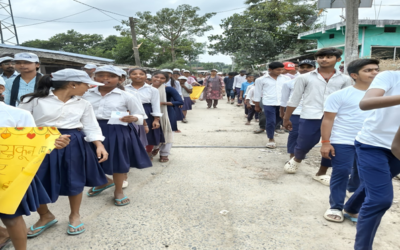I work with Centre for Social Justice (CSJ), a legal aid organisation in Ahmedabad, Gujarat. Foremost of CSJ’s vision is to create a network of legal aid centres across India. One of our centres is setup in Umarpada block of Surat district. This dainty quite block is predominantly a tribal area, some of these villages were displaced during the construction of Tapi Dam, some are the benefactors of Forest Rights Act (FRA), 2006 but all for a fact are closely connected with their People (Jan), Forest (Jangal), Land (Jameen) and Animals (Janwar).
As a part of our field visits, we visited Ghanawar village. Ghanawar has two community of people – Adimjit and Farm labours. Adimjit are the bamboo tokri makers and farm labours, who are mostly working in sugarcane farms.
Among the silent yet occupied village of Ghanawar, I met a man hailing from Uttar Pradesh. He was there for business, sitting on a decent bike with a cool boy attitude. He had cartoon stickers hanging from one side of his make-shift shop/ carrier and the largest portion of the carrier filled with kitchen utensils and daily utilities. Intriguing to me, that the demands of a far off markets are also been mitigated, my mind giggles at the sight of a perfect market example in this distant village.
But then, I tried to inquire more. How many rounds he does around here? Is his effort worth the amount he could earn from a village full of farm laborers and bamboo artisans? Also, the fact that village shops had the per unit cost oscillating between Re 1 to 5. Did they even have enough money to buy much utensils? It’s unsure whether the villagers could pay in cash or not but he was there to sell utensils in return of ‘hair’. A middle aged women, walks past me with handful of curly hairs and the man instantly put the hair in his white sack and gives her a small steel bowl.
How do you know the cost of that hair ball without weighing it?
I am in this business for the past 11 years, that much hair is worth Rs. 25; I can tell it from experience.
All this time, I am too shocked to give back a reassuring smile. So, he went on to tell me more about his distinct job. I earn around Rs. 1000- Rs. 2000 in a day, it’s a good business. I am earning well.
What happens to all this hair?
Humko kya krna hai usse. Kolkata jaata hai baal. (Translation: “Why would I care about that? Most of this gets transported to Calcutta”)
I have a mixed feeling about this incident. All the villagers seemed okay with the practice. There was no taboo about it except the fact that majority of married women wore a long cloth on their heads, covering the reality of their tethered headscape. A practice that shocks me beyond words, was apparently a well-known fact for Sardarbhai (CSJ’s paralegal at the Umarpada legal aid centre). He himself is an Adivasi living in a similar quaint village. Later in the evening, we visited his house and to my wonder, even his wife wore that long scarf. Probably she had also exchanged her hair for utensils in the past or maybe she does it even today. But, then who am I to judge the existence of barter? Who am I to click pictures of these women with long scarves or to make videos of the barter taking place? Nobody takes my picture when I ask for chocolates in return of a friendly favor.




Provocative read. Write more! 🙂